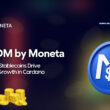This post is the first part of a long article covering all the positive aspects of Cardano. It was adapted from a thread originally posted by @Flantoshi on Twitter
Disclaimer
The title is clickbait, though clickbait I intend to deliver on as I aim to provide a solid investment thesis for Cardano. THAT SAID nobody should or shouldn’t buy something because a dessert told them to do so online. Cardano is not a cult, and everyone’s financial situation is different.
The worst vice is advice, never listen to anyone who goes out of their way to give you their opinion. I primarily write these to gain notoriety in the community, as I’m a freelance ghostwriter, and want to drum up business by showcasing my skills.
So no, I’m not a financial advisor and don’t know what assets would best fit your portfolio. The other week I even wrote a long article “Why you SHOULDN’T invest in Cardano,” where I address the project’s weaknesses. So it’s far from an open and shut case.
That said, over 90% of my net worth is presently in the Cardano ecosystem. I believe in it with conviction, so much so that work associated with it, has more or less become my full-time job.
I think that should be enough ass-covering for me not to get sued, so onwards with what you actually came here to read!
Introduction
At the time of writing, Cardano is the eighth-largest cryptocurrency by market cap.
It was one of the first at-scale Proof of Stake blockchains and has been in operation since 2017. During that time it has survived many major blows, such as the crypto-winter, and essentially had to rebuild itself after it was determined it had a suboptimal design.
To a certain extent, it could be categorized as an offspring of the school of Ethereum. Its founder, Charles Hoskinson, was also an early Ethereum co-founder but split with the project over philosophical differences.
Chiefly, Charles wished to make the developing organization of the Ethereum blockchain a for-profit entity, as opposed to Vitalik Buterin, Ethereum’s creator, who wished the blockchain to be developed by a nonprofit.
Both approaches have their merit:
- The nonprofit approach allows for a more organic development style. A good example thereof is the Linux operating system, which has been argued wasn’t developed, so much as evolved from thousands of different competing versions.
- The for-profit approach allows for a clearer hierarchical organization and definition of the goals. Moreover, it allows the organization to be able to interact with corporate entities at their same level.
Cardano ended up as a mixture of both worlds, in that the Swiss-based non-profit company Cardano Foundation, which legally holds the IP and associated branding rights, hires Charles’ company Input Output HK (IOHK) to develop the blockchain.
In other words, it’s a means by which they can benefit from the associated strengths of both worlds. At the start, Cardano benefits from having a fixed entity that can call the shots and focus the project in a productive direction.
Then, following some time, IOHK’s influence lessens and if the aggregate community so chose, they could opt for a looser structure akin to Linux’s where individual contributors could propose changes that the wider community can decide to implement.
Cardano has always had a clear goal in regards to its ultimate ambitions – in its own words:
“Cardano began with a vision of a world without intermediaries, in which power is not controlled by an accountable few, but by the empowered many. In this world, individuals have control over their data and how they interact and transact. Businesses have the opportunity to grow independent of monopolistic and bureaucratic power structures. Societies are able to pursue true democracy: self-governing, fair, and accountable. It is a world made possible by Cardano.”
As opposed to the typical crypto project, Cardano realizes that if blockchain technology is to meaningfully impact the world, it must focus on real-world applications, as opposed to catering to the cryptobros in their mothers’ basements.
In another article, we mentioned that even in well-developed countries like the US only 16% of people had interacted with crypto. And fewer than that had meaningfully used the protocols as they just used trading platforms like Robin Hood to trade instead of using it.
Put simply, most crypto projects are fighting for a relatively niche audience, and simultaneously ignoring over 84% of potential customers, alongside most of the economic activity that happens off-chain.
This is in stark contrast to Cardano, which doesn’t want to be a nice addition to the financial system, it wants to be THE financial system of the future.
In this article, we will be exploring why Cardano is potentially a good investment.
You’re thinking way too small
It’s difficult to highlight just how inconsequential crypto is as an industry when compared to finance as a whole. At the time of writing, the global crypto market cap is $1.78 trillion, which sounds quite respectable.
But we can poke some holes into it. Firstly, a bit of the value is airy-fairy and subject to change quite quickly. Market cap, while the best shorthand available to us, is not a great measure of value.
For instance, the Youtuber Max Fosh abused this metric to become the richest person on the planet (on paper) as a joke. What he did was simple: create a limited company, divided ownership of said entity into 10 billion shares and then sold a single share for £50 to a rando on the street. As such, on paper, he gained a net worth of £500 billion instantly.
Naturally, this is nonsense, and bordering on illegal. He got slapped with a stern legal warning by the authorities basically as soon as he did it, as the world of traditional finance is quite regulated. Cryptoworld though is a whole different game, and this kind of abuse is not only normal but encouraged with token burning, vesting periods, artificially limiting supply, etc.
In either case, we’re getting off track. Crypto looks huge as an industry, but it’s not. There’s a lot of smoke and mirrors designed to give you the impression it’s bigger than it is.
Microsoft, the tech company, is by itself 20% bigger than all of crypto. And if we start looking at sectors of the world economy, instead of individual companies, crypto is an inconsequential rounding error.
Furthermore, even the world economy is paltry when we start playing around with financial instruments. What if I told you that the vast majority of value in the world economy is trapped in derivatives, essentially financial bets between unfathomably rich parties?
In 2020, the world GDP was $84.71 trillion, while the total value of the derivatives market in that same period was $582 trillion. Put simply, outstanding financial contracts held almost seven times more value than the total productive capacity of the planet.
This is why it looks so petty for crypto projects to fight over crumbs. There is legitimately no need to fight over the paltry domains that have been established when you could feasibly capture this outstanding value.
Derivative contracts are exceedingly open to disruption, as the main risk with them is counterparty risk, where you can’t verify that the other party is honouring their portion of the agreement. This is child’s play for blockchain technology, as transparency is more or less a prerequisite for the tech (excluding where it’s deliberately obfuscated).
When people say that ADA can’t possibly go above $10 because of its market cap, it’s a failure of the imagination – especially when Cardano intends to be the base layer to transfer value in the world. Just to make a point, in the crazy scenario where Cardano manages to absorb the total value locked of the derivatives market, that’s an implied per coin value of $12,933.
I’m not saying that it’s gonna happen tomorrow, or the day after, or that it’s going to happen at all. But the broader point is that if Cardano succeeds in replacing the financial markets, and becoming a network that underpins everything from identity management to intellectual property rights, even the most insane of moonboy predictions might seem quite conservative in hindsight.
This is one of those few projects that genuinely has a chance to be used in some capacity by every person that exists or that could exist in future – much like personal computers or the internet. As we’ve discussed before though, if Cardano succeeds, most people will likely have no idea that it even exists – it’ll be like DNS or AWS systems, which every single person reading this has used today, but most people have no idea what they are (nor do they care).
Cardano’s built differently
It’s strange to say, but I usually don’t like investing in tech products. It’s not that I’m a Luddite, or that I don’t believe that technological progress is possible. But there are a few aspects about it that just ring alarm bells in my head.
We’ll get to the specifics some other day, but for now, I’ll just say that the sector’s over-reliance on abstract metrics like “intangible value” cause it to occasionally make investors make severe errors of judgement, which just aren’t possible in more traditional and boring sectors of the economy.
Another of my pet peeves is Silicon Valley’s culture. For the last few decades, they’ve been conditioned to believe that problems are easily solvable by putting a few sweaty nerds and some pizza in a room together.
It’s worked so far, and thus the mantra that Facebook popularized of “move fast and break things.” It doesn’t matter who, or what gets in the way, the sheer autistic zeal of the nerds will manage to overcome it sooner or later.
I’d even go as far as saying that Silicon Valley culture is willing to move fast and break things because they’re convinced that the things that will inevitably get broken, don’t belong to them.
But what happens when you aren’t allowed to break things though, or when people’s lives are on the line? Then they don’t have any good operating procedures in place.
On the other hand, Cardano is fastidious in its correctness and thus it’s a very solid base to build from. It’s often been criticized for using Haskell, a function-oriented programming language, which makes it difficult to program, but easier to find vulnerabilities in the code.
So while it is true that the available talent pool that can be used for the development of Cardano is smaller than with other protocols, the end result is worth it. There’s a reason why it’s commonplace for FinTech companies, and organizations like Facebook that process sensitive information, to use Haskell for their code.
The means by which Cardano develops their technology is deliberately slowed down and optimized for correctness and efficiency, not implementation speed.
This fastidiousness is not to show off but to allow for the proper development of Cardano as a protocol that gets used over the long term. It bears saying though that just because the base protocol is designed with correctness in mind, it’s not a guarantee that the Dapps that are developed on top will always be secure.
This point was recently underlined with the Minswap Decentralized Exchange on Cardano, where competitors found a bug that would’ve enabled some nefarious user to steal over $195m in funds. The disaster was narrowly avoided, but it’s a matter of time before there is a major exploit that destroys one of the flagship projects.
Yet, if anything, this shows just how important it is for Cardano to focus on security and correctness. Mistakes will happen, but if you can make sure that the base layer is protected, you can at least minimize the chances of catastrophic failures which can set you back years, or even put you out of commission permanently.
Cardano aims to build for the long term, for the coming decades, not just the next investor meeting.

Tech startups have no answers for when there isn’t low hanging fruit to be picked and when they can’t build the track of the train they’re in the process of driving. That’s where Cardano’s fastidiousness truly shines.
To ensure that its engineers are approaching the problems in the most efficient way possible, first, they conduct research. Then they publish said research papers and use peer review so that the wider academic community can poke holes in their methodologies and assumptions.
This grants them access to all manner of thinkers that have no interest in doing commercial work but put their enviable intellects at solving problems. As such, the wider cryptographer, programming, and system engineering community can criticize and build on the work that Cardano has done.
131+ research papers later, Cardano has become a thought leader in its own right. As much as it pains them to admit it, major crypto projects occasionally take from the knowledge accrued by Cardano.
For instance, Polkadot, a leading and groundbreaking crypto project in its own right took principles from Cardano for its consensus mechanism. Their Blind Assignment for Blockchain Extension (BABE) system is a block production engine that was inspired by Cardano’s Ouroboros Praos.
This is especially interesting in the longer term if different projects adopt Cardano-inspired design principles as it will allow for comparative synergies and interoperability between projects. The future is unlikely to be governed by a single blockchain, instead, there are likely to be projects that serve different purposes: finance, logistics, critical data management, etc.
And if we embrace this, rather than fight it, we can build with the intention of being able to bridge the different projects together and mutually benefit from them.
Entirely Different Business Models
Unlike many other of the top coins out there, Cardano is not an offshoot of Bitcoin or Ethereum. Instead, it was built from the ground up based on key insights provided by all available schools of thought.
From an influence standpoint, Cardano is an eclectic mix of ideas from various blockchains, big and small, along with theoretical concepts that had only been trialled in the minds of academics beforehand.
However, this interesting approach has lent it to developing some unique traits.
In evolution, there are “spandrels”, which are traits that are developed to address a specific problem, but through pure random chance, they have unique secondary effects and utilities that may outshine the original purpose that was meant for them.
For example, feathers might’ve originally developed in dinosaurs to keep them warm, as a crude form of insulation. However, they also have the side-effect of creating air resistance. So, some animals with feathers might be able to glide from great heights, instead of crashing down to their deaths. Over the span of millions of years, this slight advantage might have been a strong enough selection pressure so as to promote the ability to fly!
Unique applications that enhance utility in one aspect, might have interesting uses elsewhere.
We are already beginning to see the early stages of this happening. The complexity that is developing from certain key differences in Cardano is quite interesting.
A good case study of this is that of Cardano’s means of tabulating different assets. Cardano uses an innovative Extended UTXO accounting model to support multi-assets and smart contracts. I’m not going to go into detail as to the specifics of how this works, as I think IOHK have done a good job of explaining it by themselves.
The important bit of what this does is that it allows for several things that vastly improve transactions on Cardano:
- Fees required for a valid transaction can be predicted prior to execution;
- Transactions can have multiple beneficiaries, so thousands of people can receive millions of tokens with the same transaction, and at the cost of pennies.
- The success or failure of transaction validation depends only on the transaction itself and its inputs, and not on anything else on the blockchain.
This EUTXO system allows for the development of apps that would be unfeasible or horrendously expensive if they were found on other blockchains.
For instance, DripDropz is a service that the Cardano community can use to receive tokens that projects are “airdropping” to users. It bears saying that these startups don’t necessarily want to give free stuff to the community just for fun, but due to a need to decentralize their ownership due to regulatory concerns, as well as to create liquidity and (hopefully) adoption.
In other words, an accounting quirk of how Cardano processes data has deep effects on the type of business models that are possible to operate on it.
There are many other things that we can mention, but we’d be here all day. So we’ll just go to a lightning round and mention two of the more exciting ones:
Initial Stakepool Offerings (ISPO) – are stakepools run by startups to use ADA rewards received from delegation as a means of funding the development of their project. In exchange for foregoing the bulk (or all) of their rewards, delegators receive tokens from the Dapp. It’s a means of investing in a project without actually spending anything other than just opportunity cost.
Interesting to note that this business model that’s become so commonplace, wasn’t originally considered in the protocol. It was an emergent phenomenon that evolved from having the option of setting the stakepool margin fees at 100%.
Catalyst Funding – A fraction of each transaction on Cardano is earmarked and sent to a treasury that is under the control of the community. Every six weeks, the community can utilize these funds to fund interesting ideas.
There have already been major projects which have developed from it, like the Minswap DEX, which has the highest TVL in Cardano by a considerable margin. However, that’s still a pretty straightforward startup that could’ve feasibly been funded by other means, as the path towards profitability is fairly straightforward.
On the other hand, there are bound to be initiatives that are useful to have as a blockchain, but unprofitable to run and manage. Think of something like public lighting or Wikipedia. Everyone benefits from it, but if a private business were to try to charge for its services it would be a disaster; as it needs to be widely available for it to be useful, and thus you can’t erect paywalls around it.
Soon, we will begin to see the development of unprofitable and useful projects that are solely funded by this system architecture. They will be our loss leaders, similar to how supermarkets deliberately choose to lose money when selling basic goods like milk or eggs, in a bid to attract shoppers.
Other blockchains will have to do without them.
Interlude & Momentary Conclusion
Today we elaborated on the broader scope of things. We put in the groundwork of how to think about Cardano and its approach to things.
We discovered that the potential ceiling for Cardano is far, far higher than we might have expected, as it pays to be different and to think things through.
But this is barely the start of our adventure. In the weeks to come, I will be publishing the subsequent sections of this analysis, where we will be digging into what makes Cardano special.
I’ll see you next time when we will discuss the democratized & decentralized nature of Cardano and how this can help it beat the competition in the long run!
—–
If you’re in the crypto or in the traditional finance industry looking for someone to ghostwrite content for you or consult regarding your content strategy, please do not hesitate to message me. I’m a full-time content producer.
Join the community over at @flantoshi on Twitter.
And if you would like to support this project and help me pay rent, I’ll pass on the tip hat and you can send ADA to:
- Adahandle — $flantoshi
Thank you for your support!










